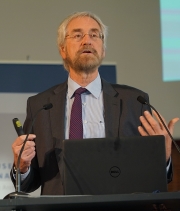
Defining the appropriate level of mutualization for the European Monetary Union (EMU) is one of the key issues on the current policy agenda. Against this background, the SAFE Policy Center held its 5th Frankfurt Conference on Financial Market Policy on the topic of “EMU: How Much Federalism?” on 27 October 2017 at Goethe University Frankfurt. After introductory remarks by Jan Pieter Krahnen, Program Director of the SAFE Policy Center, Peter Praet (Member of the Executive Board of the European Central Bank, ECB, and Chairman of the SAFE Policy Council) gave a keynote address on the topic of the conference.
Praet reviewed the evolution of federalism in the EU. He reminded the audience that the economic climate had changed within the last ten to fifteen years and that the current sentiment was not so much in favour of free trading anymore. Praet called for further integration in Europe, not only in times of crisis but also during times of economic recovery to counteract renationalisation threats. Thereby, the completion of the Banking Union and the creation of a European Capital Markets Union should be considered as key priorities. However, he conceded that the implementation process and the length of the transition period were major challenges.
Common monetary policy without risk sharing
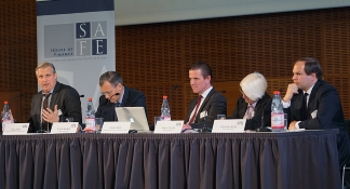
The first of three ensuing panels dealt with the question “Common monetary policy without risk-sharing?” and was chaired by Günter Beck (SAFE and University of Siegen). Ulrich Bindseil (ECB) gave an overview of the financial risk management of central banks, highlighting both the similarities and particularities compared to normal banks. He illustrated the risk sharing rules of the Eurosystem and raised the question whether risk sharing was necessary for monetary policy operations. Falko Fecht (Frankfurt School of Finance & Management) stressed the importance of well-integrated retail markets for banks in the EU. According to Fecht current ECB policy is undermining the correct pricing of bank risks by accepting zero-risk weights on sovereign bonds. Christian Kopf (Union Investment) stated that risk sharing is necessary for a common monetary policy and that the ECB plays a central role in this regard. Anne Le Lorier (Banque de France) outlined recent developments in the European collateral framework and referred to empirical evidence of its effectiveness.
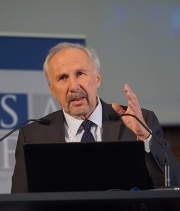
In the second keynote of the conference, Ewald Nowotny (Governor, Österreichische Nationalbank) discussed the role of transfer payments within the EMU as a mechanism to counterbalance significant differences in the macroeconomic development of the member states. According to Nowotny the EMU is a transfer union with some legitimate limitations and is rightly so, despite a strong criticism of some member states. The Governor of Österreichische Nationalbank gave several examples of EMU transfer elements and highlighted the transfer payments as one of the most important limitations for the idea to enhance the cohesion of the European community. Subsequently Nowotny argued in favour of the plans to enlarge the ESM and recommended a more fundamental role for the ECB, with a focus on a long-term perspective.
Banking Union – What type of backstop?
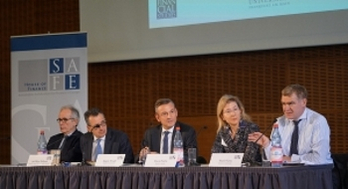
The second panel, chaired by Jürgen Schaaf (ECB) discussed the question “Banking Union – what type of backstop?”. Ignazio Angeloni (ECB) pointed out that backstops and supervision are both needed as two complementary elements. According to him, the resolution framework is more important than a common European Deposit Insurance. Mario Nava (European Commission) stated that the need of a common backstop was undisputed. He underlined that the backstop should be fiscally neutral and its establishment should be subject to the fulfilment of some conditions. María Nieto (Banco de España) stressed that depositors would have a claim under a European Deposit Insurance System (EDIS) while creditors do not have a claim under the Single Resolution Fund (SRF). She further suggested to merge SRF and EDIS (which has yet to be created) into a single fund. According to Jan Pieter Krahnen (SAFE and Goethe University) the Bank Recovery and Resolution Directive (BRRD) is one of the great achievements of the EU regulation after the financial crises, even “if it is yet unfinished. We need to implement bail-in such that it is sustainable”, Krahnen said. Hence, the bail-in rules within the scope of Total Loss Absorbing Capacity (TLAC)/Minimum requirement for own funds and Eligible Liabilities (MREL) had to be enforced credibly. Krahnen illustrated that between TLAC and securitized deposits is a portion of conditional bail-in which is subject to bank run risk, as investors will immediately withdraw their assets if a bank gets into trouble. According to Krahnen this bank run risk may undermine bank stability. He therefore suggested to set an upper limit of bail-in with a credible bailout guarantee beyond that bail-in level – possibly in form of a European public backstop.
Euroland – how much mutualization?”
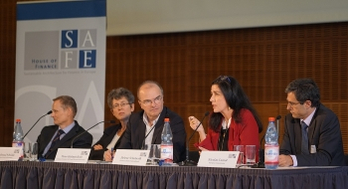
The third panel which was moderated by Hans-Helmut Kotz (SAFE and Harvard University) focused on the topic “Euroland – how much mutualization?”. Nicolas Carnot (European Commission) stated that “it is important that each country does its own homework first”. He called for reforms to assure financial resilience in Europe and reminded the audience that “common mechanisms are crucial if there is a loss in trust”. According to Ludger Schuknecht (German Federal Ministry of Finance) a large degree of mutualization in Europe already exists, for example via the ESM or a common monetary policy. In his opinion, further reforms need to be designed incentive compatible to avoid moral hazard and re-establish trust in European institutions. Given the lack of political consensus for further mutualization, Helene Schuberth (Oesterreichische Nationalbank) proposed European Safe Bonds (ESBies) as a possible solution. According to her, resolving the fragmentation of national bonds markets and creating a common European safe bond would create significant advantages. Waltraud Schelkle (London School of Economics) took the perspective that “because of the common currency, the sovereigns within the Eurozone have lost an important policy tool, requiring more monetary solidarity to cope with large overall shocks.” She further stated that moral hazard was mainly a bank issue and less a political one. She proposed “catastrophe bonds” which default automatically if a predetermined triggering event occurs.

